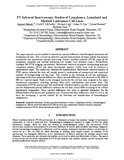- CERES Home
- →
- Cranfield Health
- →
- Staff publications - Cranfield Health
- →
- View Item
JavaScript is disabled for your browser. Some features of this site may not work without it.
| dc.contributor.author | Babrah, Jaspreet | - |
| dc.contributor.author | McCarthy, Keith P. | - |
| dc.contributor.author | Lush, Richard | - |
| dc.contributor.author | Rye, Adam D. | - |
| dc.contributor.author | Bessant, Conrad M. | - |
| dc.contributor.author | Stone, Nicholas | - |
| dc.contributor.editor | Dietrich, Schweitzer | - |
| dc.contributor.editor | Maryann, Fitzmaurice | - |
| dc.date.accessioned | 2012-10-01T23:04:05Z | |
| dc.date.available | 2012-10-01T23:04:05Z | |
| dc.date.issued | 2007-12-31T00:00:00Z | - |
| dc.identifier.citation | Jaspreet Babrah, Keith P. McCarthy, Richard Lush, Adam D. Rye, Conrad Bessant, Nicholas Stone. FT-infrared spectroscopic studies of lymphoma, lymphoid and myeloid leukaemia cell lines. Proceedings of SPIE-OSA Biomedical Optics : Diagnostic Optical Spectroscopy in Biomedicine IV. Munich 19-21 June 2007, pp1-7 | |
| dc.identifier.isbn | 9780819467720 | - |
| dc.identifier.uri | http://dx.doi.org/10.1117/12.728220 | - |
| dc.identifier.uri | http://dspace.lib.cranfield.ac.uk/handle/1826/7606 | |
| dc.description.abstract | This paper presents a novel method to characterise spectral differences that distinguish leukaemia and lymphoma cell lines. This is based on objective spectral measurements of major cellular biochemical constituents and multivariate spectral processing. Fourier transform infrared (FT-IR) maps of the lymphoma, lymphoid and myeloid leukaemia cell samples were obtained using a Perkin-Elmer Spotlight 300 FT-IR imaging spectrometer. Multivariate statistical techniques incorporating principal component analysis (PCA) and linear discriminant analysis (LDA) were used to construct a mathematical model. This model was validated for reproducibility. Multivariate statistical analysis of FTIR spectra collected for each cell sample permit a combination of unsupervised and supervised methods of distinguishing cell line types. This resulted in the clustering of cell line populations, indicating distinct bio-molecular differences. Major spectral differences were observed in the 4000 to 800 cm- 1 spectral region. Bands in the averaged spectra for the cell line were assigned to the major biochemical constituents including; proteins, fatty acids, carbohydrates and nucleic acids. The combination of FT-IR spectroscopy and multivariate statistical analysis provides an important insight into the fundamental spectral differences between the cell lines, which differ according to the cellular biochemical composition. These spectral differences can serve as potential biomarkers for the differentiation of leukaemia and lymphoma cells. Consequently these differences could be used as the basis for developing a spectral method for the detection and identification of haematological malignancies. | en_UK |
| dc.title | FT-infrared spectroscopic studies of lymphoma, lymphoid and myeloid leukaemia cell lines | en_UK |
| dc.type | Conference paper | - |
